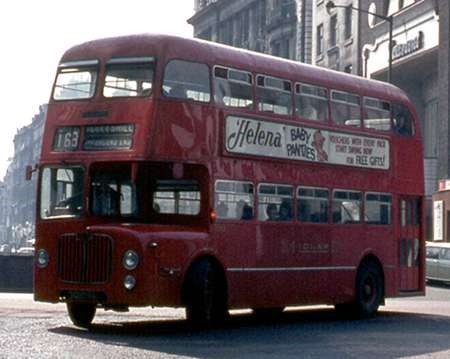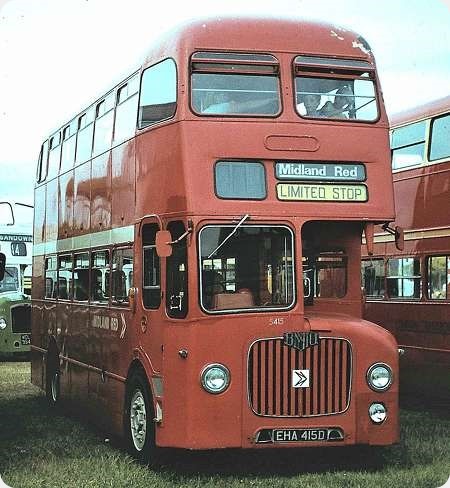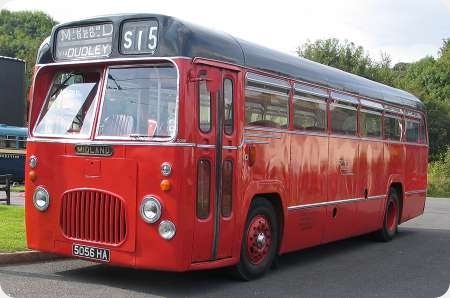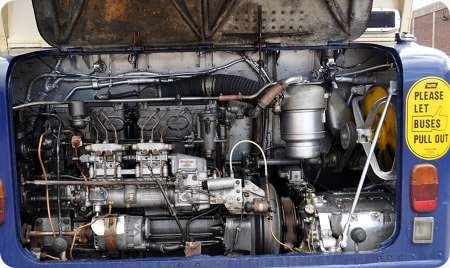Midland Red – BMMO D9 – EHA 415D – 5415
Midland Red (Birmingham & Midland Motor Omnibus Co)
1966
BMMO D9
BMMO/Willowbrook H40/32RD
EHA 415D has the unmistakable outline of a Midland Red D9. She has the operator’s own H72RD body, built in collaboration with Willowbrook. Does this mean one designed it and the other built it, or one built the frames and the other added the panels? We see it, newly withdrawn from service and still in full NBC livery (sorry!), in the Southsea rally on 8 June 1980.
Photograph and Copy contributed by Pete Davies
10/11/16 – 07:07
I wasn’t aware that Willowbrook had any involvement in the bodywork of the D9, but I am open to correction if evidence is offered. My understanding is that the bodies were built in the Midland Red Carlyle Works on MetSec frames, and incorporated aluminium alloy and glass fibre panelling, as employed previously in the single deck S14 design.
Roger Cox
10/11/16 – 07:08
It’s come back! Its no good- I have lived in the Midlands in my youth, but I still cannot get fond of Midland Red. I don’t know what it is- that all over red (It was, want it?), or I can still see those single skin fibreglass domes (is that right- how much more was single skin?) or what seemed rather drab uniform interiors… or I could never get used to that sort of "Billy’s bus" front end: but steady, I’m sure they had many virtues: perhaps they were an engineer’s bus…?
Joe
10/11/16 – 09:05
Roger, The PSVC lists might be wrong: they say that the D9 has a BMMO/Willowbrook body, with H40/32RD seating, but both Jenkinson and the old "Ian Allan" BBF listings do not mention Willowbrook. BLOTW, however, mentions only Willowbrook as building the bodies. Ah, well . . .
And the ‘captcha’ code for this comment ends in D9 !!!
Pete Davies
10/11/16 – 09:05
According to ‘Midland Red’ A history of 1940 – 1970 it states "5401-45 bodies completed by Willowbrook"
Peter
10/11/16 – 13:54
The D9 was an integral vehicle, the only double decker so constructed apart from the London Transport Routemaster, which was actually semi-integral. Production of the D9 came in several batches with the following fleet nos:-
4773 : prototype 1958
4849 – 4952 : 1958 to 1961
4945 – 5044 : 1962 to 1963
5296 – 5445 : 1963 to 1966
I confess to being previously unaware of it, though a closer look at my copy of ‘Midland Red Buses’ by M.W. Greenwood confirms that the 45 "tail end charlies" were finished off by Willowbrook, possibly in part because by this time, even before the BET sell out to NBC, BMMO in house production was winding down. Certainly, the D9 design itself owed nothing to the Willowbrook company.
Roger Cox
10/11/16 – 14:37
I have looked at Steve Richards’ book on the D9/D10 classes, titled "More Room on Top". He states that all the D9s were built at Central Works, except some of the final batch. However by the mid-sixties there was a severe skilled labour shortage at Central Works. The emphasis there was on single-deckers construction, and the final 45 D9s had only reached the part-panelled stage. It was this group which were completed by Willowbrook. They were virtually indistinguishable from the fully Carlyle-built D9s. Steve Richards records that the side lamps were positioned slightly lower, and the small "Midland" display above the destination screens was slightly different. The first four [5401-5404] were delivered in December 1965, the rest followed in 1966, finally being completed in November that year. I would say from this account that these particular ones should be described as "BMMO/Willowbrook" rather than being attributed wholly to the Loughborough company.
Michael Hampton
10/11/16 – 14:38
Although at the time I had little interest in the detail construction of buses, I do know that when I had the pleasure to drive D9’s in service in 1967 from Redditch and Digbeth garages I found them to be far superior in steering, semi-automatic gear changing, engine power, superb disc braking and general driver friendliness than anything I had driven on BCT. One slight problem I remember them to be very light and bouncy in the ride especially when empty. I certainly class them in the 3 finest double deckers to drive in my 50yrs experience with PSV’s, with the Routemaster and Neoplan Skyliner
Tony Morgan
11/11/16 – 05:44
The erroneous idea that Willowbrook constructed, rather than merely completed, the bodies on the final 45 D9s seems to have crept into all sorts of places, even on the Coventry Corporation Transport Society webpages :- //www.cct-society.org.uk/midland/buses_t05.htm

Here is a picture of an earlier D9 No.5002 (3002 HA) taken in Birmingham in the late 1960s, when the bus still wore the BET style livery and fleetname. Like its single deck counterpart, the S14, the suspension of the D9 was by Metalastik rubber units, though independent at the front. One curious feature of the D9 was the full hydraulic braking system in which the pump was driven from the output side of the gearbox, giving rather peculiar braking responses at low road speeds. In the Routemaster, the pump was driven at engine speeds. The prototype D9 originally had disc brakes at front and rear, but the first production batch had discs on the front only, with drum brakes on the rear wheels. Even these discs proved troublesome, and all the later D9s were equipped with drum brakes all round, the first batch being retro fitted accordingly. I note Joe’s impassioned plea concerning this operator, so I hope soon to submit a gallery of Midland Red buses to the OBP site for his enjoyment.
Roger Cox
11/11/16 – 08:01
Apparently this vehicle sometime in the seventies carried an all over advertisement for a ‘Do It Yourself Warehouse’ which could have been called ‘Super D’. I think it was in an all over white livery.
Also just above the top front windows a strengthening bar can be seen which was added due to front dome fatigue.
Peter
11/11/16 – 08:01
This has been an interesting exchange of views! Thanks for your comments.
Pete Davies
12/11/16 – 07:17
Attached for comparison a side image of 5395 taken in Shrewsbury bus station in 1970.
I enjoyed riding on the D9s particularly on the rural services. An unusual feature was the inward facing front nearside seats downstairs. The book ‘ More room on top ‘ is recommended although I am biased as a friend contributed a number of excellent colour photos.
Keith Newton
12/11/16 – 07:19
I’ve seen the obvious now- that the D9 had a considerable front overhang which gives it its funny look- but as Tony says it’s an Engineer/Driver’s bus… and anything comparable with a Skyliner must be OK. We’ve been here before but compare this overhang & everything else with its contemporary the Wulfrunian and you can see how folk were thinking then, especially if rear-engine to them meant Renault 10!
Joe
16/11/16 – 14:45
It was not only D9s that were finished off by Willowbrook. S17s around the same time were and I believe both Willowbrook and Plaxton were used. Serious production difficulties caused by skilled staff shortages. Interestingly outside contractors were not used for the later S21 and S22 types but Plaxton were used for S23 by which time all production was stopping. Although every D9 appears to have been modified and allegedly no two buses were the same, the Willowbrook finished ones are identifiable by the trim above the front wheel arch. MidlandRed.net is a good source of information.
Sam Caunt
01/02/17 – 17:12
I have only just seen the comments re Willowbrook completing D9s. I can remember seeing them in skeletal form travelling along the then A50 towards Coalville. Their destination was confirmed by my father who was based in the divisional traffic office in the 1960s. The drivers would have had to take the scenic route round Ashby in order to avoid two low bridges, hence their appearance in Coalville. I am unable to say which route they used onwards to Loughborough, but the M1 would have been available from November 1965!
Peter Baseley
22/11/17 – 07:31
I must comment on the subject of the BMMO D9 (and BMMO’s in general) as a former Midland Red engineering supervisor of 25 years service.The bodywork of the Willowbrook examples might have been finished by them but the chassis was certainly built at Carlyle works-the works itself did not close.The D9 was of monocoque construction and would have had the outer panel skin added by the coachbuilders.A few more facts:D9’s were NOT disc braked,except the prototype 4773,the rest were all round hydraulic drum braked,unlike the single deckers.4773 by the way still survives,being currently restored from derelict condition.D9’s may or may not have been single skinned but they were sturdy and stable enough,as anyone who compared a ride upstairs on one with a Fleetline (DD11) on the 658 Leicester-Coventry service-the Fleetline swayed about like hell (a well known trait of Fleetlines in crosswinds.) In general BMMO’s WERE an engineer’s bus,easy to work on and reliable,but also a driver’s bus,with excellent roadholding and braking.The 10.5 litre engine (same as CM6) was probably the finest the UK bus industry has produced.
What other PSV diesel engine (in a single decker) could get away with no cooling fan at all?
Michael Hunt
20/12/18 – 06:36
These were a suberb bus. the slight setting back of the front axle reduced the wheelbase slightly and I assume this was to make the bus slightly more maneuverable or perhaps the suspension design necessitated it? I think this particular feature did incur some pitching on certain types of road surface but that aside they were excellent and likes by the drivers, which speaks volumes.
I have had the privilege of driving one occasionally and the front suspension certainly irons out road imperfections.It was only the final batches that were finished by Willowbrok just as Plaxton finished some of the saloons from the same period. There are constant references to these buses loosing the power steering if the brakes were applied, the two systems were separate and I can’t see how that could happen.
William Parker
20/12/18 – 08:52
I have 5424 and restored it from the chassis up around 18 years ago. It is a curious mis-match of technologies with extensive use of fibre glass taking weight down to compensate for the very heavy engine. They are basic and built down to a price. Mine lasted 11 years in service and only 5 in preservation before being put off the road. Midland Red had innovative engineers but their lack of resource was found out when the vehicles were in service. Many Midland Red folllowers say the reason they had so many Black Country garages combined with bus stations was to make transfer to another bus easier for the drivers when they put them off the road
Roger Burdett
Quick links to the - Comments Page - Contact Page - Home Page






